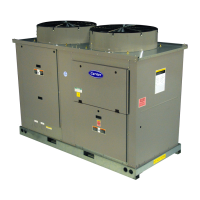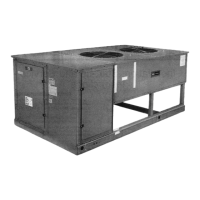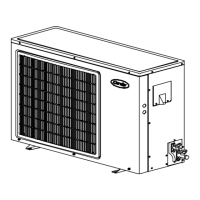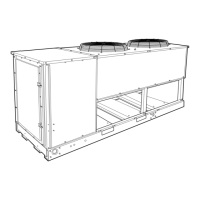40
Outputs — In addition to the capacity staging outputs of
the compressor or digital compressor (if equipped) and the out-
door fan staging for head pressure control, several external and
optional outputs are used for status signals and unit refrigerant
control.
ALARM RELAY — The 38AP ComfortLink units have a re-
mote alarm relay feature that allows for remote annunciation of
a unit alarm. For Alert and Alarm definitions, see the Alarms
and Alerts section on page 162. A field-installed relay, ALMR,
must be installed and connected between LVT-1 and LVT-2.
For alarm relay specifications see the appropriate machine con-
trol type wiring diagrams.
LIQUID LINE SOLENOID VALVES — The 38AP units
have the ability to control a number of liquid line solenoids de-
pending on the unit size. See Table 10.
Table 10 — Liquid Line Solenoid Valve
Connections
Two conditions will open the liquid line solenoid valves.
Each circuit operates independently. The primary liquid line
solenoid valve (LLSV-A or LLSV-B) is energized any time a
compressor is operating in the circuit. The circuit’s primary liq-
uid line solenoid is opened for approximately 20 seconds be-
fore a lead circuit compressor is started. The primary liquid line
solenoid valve is de-energized 5 seconds after the circuit stops.
If the circuit has an additional liquid line solenoid valve
(LLSV-A2 or LLSV-B2), it will be energized with the start of
the second compressor in the circuit. The second liquid line so-
lenoid in the circuit will be de-energized when the circuit re-
turns to a single compressor running.
As part of the refrigerant management routine, the primary
liquid line solenoid valve, LLSV-A or LLSV-B, is opened
when the circuit is OFF and the Outdoor Air Temperature
(OAT) is less than the circuit’s Saturated Suction Temperature
(SST). The primary liquid line solenoid will close if the circuit
is OFF and the OAT is greater than the SST plus 2° F (1.1° C).
If equipped, the second liquid line solenoid in the circuit will
not operate as part of this refrigerant management routine.
PRE-START-UP
Do not attempt to start the air-conditioning system until the
following checks have been completed.
System Check
1. Check all system components for proper operation, in-
cluding the air-handling equipment. Consult manufactur-
er’s instructions. If the unit has field-installed accessories,
be sure all are properly installed and wired correctly. Re-
fer to unit wiring diagrams.
2. Open liquid line and suction line service valves.
3. Check tightness of all electrical connections.
4. Oil should be visible in the compressor sight glasses. An
acceptable oil level in the compressor is from
1
/
8
to
3
/
8
of
sight glass. Adjust the oil level as required. No oil should
be removed unless the crankcase heater has been ener-
gized for at least 24 hours. See the Oil Charge section on
page 147 for Carrier-approved oils.
5. Electrical power source must agree with unit nameplate.
6. Crankcase heaters must be firmly attached to compres-
sors, and must be on for 24 hours prior to start-up.
7. Fan motors are 3-phase. Check rotation of fans during
first start-up check. See Condenser Fans section on
page 150 for proper rotation direction.
Evacuation and Dehydration — For evacuation
and dehydration procedures, refer to the unit installation in-
structions.
UNIT CIRCUIT
LIQUID LINE
SOLENOID VALVE
CONNECTIONS
COMMENTS
38APD025-060
A A1 LVT-25, 2
B B1 LVT-24, 2
38APD070-130
A
A1 LVT-25, 2
A2 CXB-J6-5, 6
Separate
Power Supply
Required
B
B1 LVT-24, 2
B2 CXB-J6-7, 6
Separate
Power Supply
Required
38APS025-050 A
A1 LVT-25, 2
A2 LVT-24, 2
38APS065 B
B1 LVT-25, 2
B2 LVT-24, 2
LOOP WIRE HARNESS AND
SECURE WITH WIRE TIE TO
FORM STRAIN RELIEF.
Fig. 48 — High Pressure Switch (HPS), Suction
Pressure Transducer (SPT), and Discharge
Pressure Transducer (DPT) Mounting
INSTALL NUT AND SEAL
ON THERMISTOR. APPLY
THERMAL CONDUCTIVE
GREASE TO THERMISTOR
AND WELL. INSERT
THERMISTOR INTO WELL.
LOOP WIRE HARNESS AND
SECURE WITH WIRE TIE
TO FORM STRAIN RELIEF.
INSULATE WITH
CORK TAPE
INSULATION.
Fig. 49 — Return Gas Thermistor (RGT) Mounting
IMPORTANT: Before beginning Pre-Start-Up or Start-Up,
review Start-Up Checklist at the back of this publication.
The checklist assures proper start-up of a unit and provides a
record of unit condition, application requirements, system
information, and operation at initial start-up.

